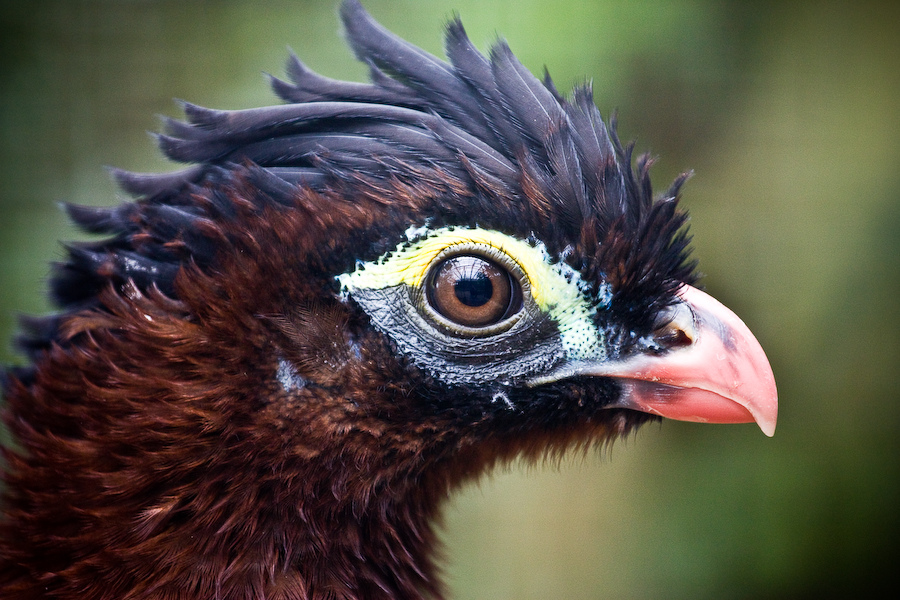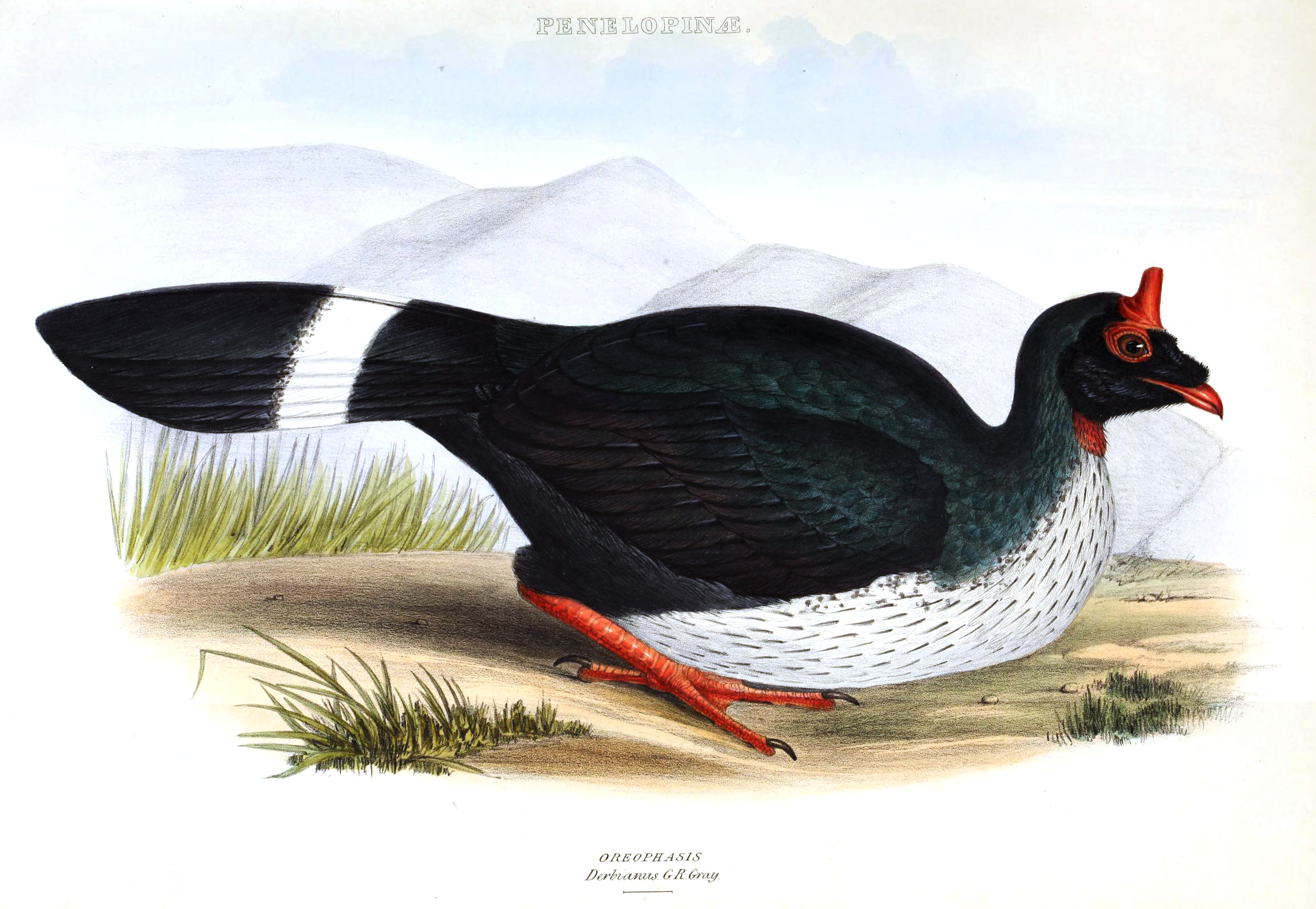|
Cracid
The chachalacas, guans and curassows are birds in the family Cracidae. These are species of tropical and subtropical Central and South America. The range of one species, the plain chachalaca, just reaches southernmost parts of Texas in the United States. Two species, the Trinidad piping guan and the rufous-vented chachalaca occur on the islands of Trinidad and Tobago respectively. Systematics and evolution The family Cracidae was introduced (as Craxia) by the French polymath Constantine Samuel Rafinesque in 1815. The Cracidae are an ancient group related to the Australasian mound-builders. They are sometimes united with these in a distinct order, "Craciformes", but this is not supported by more recent research which suggests that either is a well-marked, basal lineage of Galliformes. Phylogeny Cladogram based on the study by De Chen and collaborators published in 2021. The numbers of species are from the list maintained by Frank Gill, Pamela Rasmussen and David Donsker on b ... [...More Info...] [...Related Items...] OR: [Wikipedia] [Google] [Baidu] |
Cracinae
Curassows are one of the three major groups of cracid birds. They comprise the largest-bodied species of the cracid family. Three of the four genera are restricted to tropical South America; a single species of ''Crax'' ranges north to Mexico. They form a distinct clade which is usually classified as the subfamily Cracinae. Evolution In line with the other 3 main lineages of cracids (chachalacas, true guans, and the horned guan), mt and nDNA sequence data indicates that the curassows diverged from their closest living relatives (probably the guans) at some time during the Oligocene, or c.35–20 mya (Pereira ''et al.'' 2002). This data must be considered preliminary until corroborated by material (e.g. fossil) evidence however. What appears certain from analysis of the molecular data, calibrated against geological events that would have induced speciation is that there are 2 major lineages of curassows: one containing only ''Crax'', and another made up of ''Mitu'' and ''Paux ... [...More Info...] [...Related Items...] OR: [Wikipedia] [Google] [Baidu] |
Oreophasis
The horned guan (''Oreophasis derbianus'') is a large, turkey-like bird native to Central America. It is the only species in the genus ''Oreophasis''. Taxonomy The holotype specimen of "''Oreophasis Derbianus'' " G.R. GrayGen. Bds., 3, 1844, p.(485). is held in the collections of National Museums Liverpool at World Museum, with accession number D210. The specimen was collected from Volcán de Fuego, Guatemala by Don Joaquin Quinones circa 1843 and came to the Liverpool national collection via the 13th Earl of Derby’s collection which was bequeathed to the people of Liverpool. Phylogeny The horned guan is not a true guan, but merely resembles these birds most in overall shape and color, whereas the horn is more reminiscent of the helmeted curassows. In fact, this species is the only survivor of a very ancient lineage of cracids that has been evolving independently from all other living members of this family for at least 20 million years, and possibly as much as 40 million years ... [...More Info...] [...Related Items...] OR: [Wikipedia] [Google] [Baidu] |
Penelopina
The highland guan (''Penelopina nigra'') is a species of bird in the family Cracidae. It is found in the highlands of El Salvador, Guatemala, Honduras, southern Mexico, and Nicaragua. Its natural habitat is subtropical or tropical moist montane forest. Its population has declined much in recent times: Listed as a species of Least Concern in 1994, it was uplisted to Near Threatened in 2000 and, as it was determined to be less common than previously believed, to Vulnerable in the 2007 IUCN Red List.See BirdLife International (2004, 2007a,b). Description The highland guan grows to a length of . The plumage of the male is black, the upper parts glossed with green or blue, the underparts rather duller. The iris of the eye is reddish-brown and there is reddish-brown or purplish bare skin around and behind the eye. The beak, the bare skin on the throat, the large wattle, the legs and feet are reddish-orange. The female, by contrast, is black, heavily mottled and barred with reddish-br ... [...More Info...] [...Related Items...] OR: [Wikipedia] [Google] [Baidu] |
Galliformes
Galliformes is an order of heavy-bodied ground-feeding birds that includes turkeys, chickens, quail, and other landfowl. Gallinaceous birds, as they are called, are important in their ecosystems as seed dispersers and predators, and are often reared by humans for their meat and eggs, or hunted as game birds. The order contains about 290 species, inhabiting every continent except Antarctica, and divided into five families: Phasianidae (including chicken, quail, partridges, pheasants, turkeys, peafowl (peacocks) and grouse), Odontophoridae (New World quail), Numididae (guinea fowl), Cracidae (including chachalacas and curassows), and Megapodiidae (incubator birds like malleefowl and brush-turkeys). They adapt to most environments except for innermost deserts and perpetual ice. Many gallinaceous species are skilled runners and escape predators by running rather than flying. Males of most species are more colorful than the females, with often elaborate courtship behaviors t ... [...More Info...] [...Related Items...] OR: [Wikipedia] [Google] [Baidu] |
Penelopinae
The guans are a number of bird genera which make up the largest group in the family Cracidae. They are found mainly in northern South America, southern Central America, and a few adjacent Caribbean islands. There is also the peculiar horned guan (''Oreophasis derbianus'') which is not a true guan, but a very distinct and ancient cracid with no close living relatives (Pereira ''et al.'' 2002). Systematics and evolution The evolution of the group is fairly well resolved due to comprehensive analyses of morphology, biogeography, and mt and nDNA sequences (Pereira ''et al.'' 2002, Grau ''et al.'' 2005). The position of ''Penelopina'' and ''Chamaepetes'' - peculiar genera of which the former, uniquely among guans and more in line with curassows, shows pronounced sexual dimorphism - relative to each other is not determinable with certainty at present, but all evidence suggests that they are the basalmost guans. Their distribution is fairly far northwards, with 2 of their 3 species li ... [...More Info...] [...Related Items...] OR: [Wikipedia] [Google] [Baidu] |
Aburria
The wattled guan (''Aburria aburri'') is a species of bird in the family Cracidae. It is a fairly large black cracid with blue-based, black-tipped beak and a long, red-and-yellow wattle. It is found in Colombia, Ecuador, Peru, and Venezuela. Its natural habitats are subtropical or tropical moist lowland forest and subtropical or tropical moist montane forest. The wattled guan is a fairly shy species that is mostly seen when it perches on the outer edge of the canopy from a distance. Like many tropical forest birds, it is heard more often than seen. It is threatened by habitat destruction and the IUCN has assessed its conservation status as being "near threatened". Description The wattled guan is recognisable by the elongated red and yellow fleshy wattle that dangles from its throat. It is a large bird with a long tail, about long and weighing between . The plumage is black, the beak is blue and the feet are flesh-coloured. Distribution and habitat The wattled guan is endemic ... [...More Info...] [...Related Items...] OR: [Wikipedia] [Google] [Baidu] |
Trinidad Piping Guan
The Trinidad piping guan (''Pipile pipile'') locally known as the pawi, is a bird in the chachalaca, guan and curassow family Cracidae, endemic to the island of Trinidad. It is a large bird, somewhat resembling a turkey in appearance, and research has shown that its nearest living relative is the blue-throated piping guan from South America. It is a mainly arboreal species feeding mostly on fruit, but also on flowers and leaves. At one time abundant, it has declined in numbers and been extirpated from much of its natural range and the International Union for Conservation of Nature has rated the bird as " critically endangered". Description This is a medium-sized cracid, 60 cm in length, and similar in general appearance to a turkey, with a thin neck and small head. It is mainly black with a purple gloss. The large crest is blackish, edged with white, and there are large white wing patches. The bare face and wattle are blue, and the legs are red. The Trinidad piping guan's ... [...More Info...] [...Related Items...] OR: [Wikipedia] [Google] [Baidu] |
Frank Gill (ornithologist)
Frank Bennington Gill (October 2, 1941 in New York City) is an American ornithology, ornithologist with worldwide research interests and birding experience. He is perhaps best known as the author of the textbook ''Ornithology'' (4th edition, 2019), the leading textbook in the field. Gill was raised in Teaneck, New Jersey. He reported that he became interested in birds at the age of seven, when his grandfather, Frank Rockingham Downing, showed him a song sparrow at a birdbath. This was the first time he had seen a bird through binoculars, "and I was hooked." After Gill received his Doctor of Philosophy, PhD in zoology from the University of Michigan in 1969 (where he had also completed his undergraduate degree), he joined the ornithology department at the Academy of Natural Sciences in Philadelphia. From 1969 to 1995, Gill was a full-time staff member of the academy, where he held various positions throughout his tenure, including that of chairman for the Department of Ornithol ... [...More Info...] [...Related Items...] OR: [Wikipedia] [Google] [Baidu] |
Pamela Rasmussen
Pamela Cecile Rasmussen (born October 16, 1959) is an American ornithologist and expert on Asian birds. She was formerly a research associate at the Smithsonian Institution in Washington, D.C., and is based at the Michigan State University. She is associated with other major centers of research in the United States and the United Kingdom. Rasmussen's early research investigated South American seabirds and fossil birds from North America. She later specialised in Asian birds describing several new species and clarifying the status of others, particularly white-eyes and owls. More recently, she has been involved in large scale collaborations looking at patterns of global biodiversity, and has assessed the taxonomic status of South Asian vultures. She was the main author of '' Birds of South Asia: The Ripley Guide'', a landmark publication due to its greater geographical and species coverage compared to its predecessors. As a result of her study of museum bird specimens when resear ... [...More Info...] [...Related Items...] OR: [Wikipedia] [Google] [Baidu] |
International Ornithologists' Union
The International Ornithologists' Union, formerly known as the International Ornithological Committee, is a group of about 200 international ornithologists, and is responsible for the International Ornithological Congress and other international ornithological activities, undertaken by its standing committees. International Ornithological Congress The International Ornithological Congress series forms the oldest and largest international series of meetings of ornithologists. It is organised by the International Ornithologists' Union. The first meeting was in 1884; subsequent meetings were irregular until 1926 since when meetings have been held every four years, except for two missed meetings during and in the immediate aftermath of the Second World War. Meetings See also * '' Birds of the World: Recommended English Names'', a book written by Frank Gill Frank Gill may refer to: * Frank Gill (Australian footballer) (1908–1970), Australian rules footballer with Carlton * Fran ... [...More Info...] [...Related Items...] OR: [Wikipedia] [Google] [Baidu] |
Chamaepetes
''Chamaepetes'' is a genus of bird in the family Cracidae The chachalacas, guans and curassows are birds in the family Cracidae. These are species of tropical and subtropical Central and South America. The range of one species, the plain chachalaca, just reaches southernmost parts of Texas in the Unite .... It contains the following species: References Bird genera Taxonomy articles created by Polbot {{Galliformes-stub ... [...More Info...] [...Related Items...] OR: [Wikipedia] [Google] [Baidu] |
Central Atlas Für Zoologische Gärten (Taf
Central is an adjective usually referring to being in the center of some place or (mathematical) object. Central may also refer to: Directions and generalised locations * Central Africa, a region in the centre of Africa continent, also known as Middle Africa * Central America, a region in the centre of America continent * Central Asia, a region in the centre of Eurasian continent * Central Australia, a region of the Australian continent * Central Belt, an area in the centre of Scotland * Central Europe, a region of the European continent * Central London, the centre of London * Central Region (other) * Central United States, a region of the United States of America Specific locations Countries * Central African Republic, a country in Africa States and provinces * Blue Nile (state) or Central, a state in Sudan * Central Department, Paraguay * Central Province (Kenya) * Central Province (Papua New Guinea) * Central Province (Solomon Islands) * Central Province, Sri Lank ... [...More Info...] [...Related Items...] OR: [Wikipedia] [Google] [Baidu] |
_(6436435841)_(cropped).jpg)







.jpg)